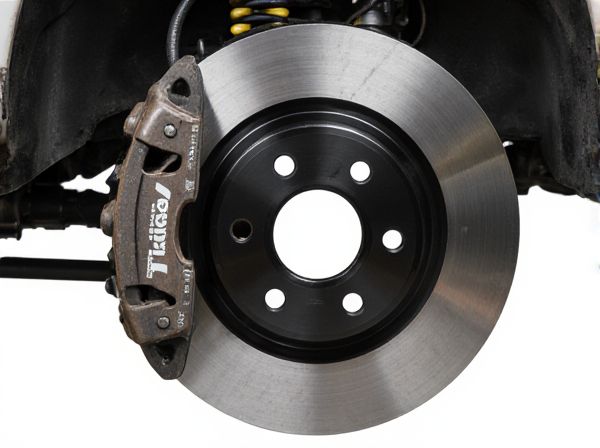
Photo illustration: Floating Rotors vs Fixed Rotors
Floating rotors offer enhanced heat dissipation and flexibility by expanding and contracting with temperature changes, reducing the risk of warping and improving braking performance during intense use. Fixed rotors provide a more rigid and stable braking surface, ideal for consistent, high-precision stopping power in racing conditions or heavy-duty applications. Choosing between floating and fixed rotors depends on your specific driving needs, balancing cooling efficiency with mechanical stability.
Table of Comparison
| Feature | Floating Rotors | Fixed Rotors |
|---|---|---|
| Design | Two-piece rotor with rotating hat and friction disc | One-piece solid rotor |
| Heat Dissipation | Superior heat dissipation, reduces warping | Less efficient cooling, prone to warping |
| Weight | Lighter due to separate components | Heavier as single solid piece |
| Performance | Better high-performance & racing applications | Common in standard passenger vehicles |
| Cost | Higher manufacturing cost | Lower cost, budget-friendly |
| Durability | Less prone to cracking and warping under stress | More susceptible to heat-related wear |
Introduction to Brake Rotors: Floating vs Fixed
Brake rotors play a crucial role in vehicle braking systems, with floating and fixed rotors representing two primary designs. Floating rotors feature a two-piece construction where the disc surface is attached to the hub via rivets or bobbins, allowing lateral movement to reduce warping and improve heat dissipation. Fixed rotors consist of a single solid piece, offering rigidity and consistent pedal feel but are more prone to heat-related deformation under extreme conditions.
What Are Floating Rotors?
Floating rotors are a type of brake rotor designed to allow slight lateral movement between the rotor and its hub, enhancing heat dissipation and reducing warping during high-performance driving. These rotors typically feature two metal discs connected by rivets or pins that enable controlled float, improving braking consistency and reducing stress on braking components. Compared to fixed rotors, floating rotors provide better thermal expansion management, making them ideal for racing and heavy-duty applications.
What Are Fixed Rotors?
Fixed rotors are crucial components in braking systems that remain stationary while interacting with moving parts such as brake calipers or pads. They provide a solid, anchored surface that allows for consistent friction generation, essential for effective braking performance. The durability and rigidity of fixed rotors contribute to enhanced heat dissipation and reduced brake fade during high-stress conditions.
Key Differences Between Floating and Fixed Rotors
Floating rotors offer enhanced braking performance by allowing slight movement that reduces stress and heat buildup, unlike fixed rotors that remain rigidly attached to the hub. The design of floating rotors incorporates bobbins or buttons connecting the braking surface to the rotor hat, enabling expansion and contraction during intense braking. Fixed rotors provide a more direct and consistent braking feel but are more prone to warping under high thermal stress compared to floating rotors.
Performance Comparison: Floating Rotors vs Fixed Rotors
Floating rotors offer superior performance by reducing friction and enhancing thermal management, resulting in more consistent braking power and less fade during prolonged use. Fixed rotors, while generally heavier, provide greater structural rigidity and better heat dissipation under extreme braking conditions, making them suitable for high-performance applications requiring durability. The choice between floating and fixed rotors depends on balancing weight, heat management, and operational consistency for optimal braking efficiency.
Heat Dissipation and Warping Resistance
Floating rotors offer superior heat dissipation due to their ability to expand and contract independently from the hub, reducing thermal stress during braking. This enhanced thermal management minimizes the risk of warping compared to fixed rotors, which are more prone to heat buildup as they lack the flexibility to accommodate temperature changes. The separation in floating rotors allows for consistent performance and greater durability under high thermal loads.
Durability and Maintenance Considerations
Floating rotors, designed with movement allowance for better heat dissipation, tend to experience less warping and uneven wear, enhancing their durability compared to fixed rotors. Fixed rotors, being rigidly attached, often face higher risks of cracking and deformation under severe braking conditions, leading to more frequent replacement needs. Maintenance for floating rotors involves periodic inspection of mounting points and sliders to prevent seizing, whereas fixed rotors require consistent monitoring for wear thickness and potential rotor resurfacing.
Application: Best Use Cases for Each Rotor Type
Floating rotors excel in high-performance braking applications such as motorsports and heavy-duty trucks due to their ability to dissipate heat efficiently and reduce brake fade under extreme conditions. Fixed rotors are ideal for everyday passenger vehicles and city driving where cost-effectiveness, durability, and low maintenance outweigh the need for advanced heat management. Industrial machinery and off-road vehicles benefit from fixed rotors for their robustness, while floating rotors enhance performance in scenarios demanding superior thermal regulation and precision braking.
Cost Analysis: Which Rotor Offers Better Value?
Floating rotors generally have higher initial costs due to their complex design and manufacturing processes but offer better performance and durability, reducing long-term maintenance expenses. Fixed rotors are more affordable upfront and simpler to produce, making them suitable for budget-conscious projects with lower performance demands. Evaluating total cost of ownership, floating rotors provide superior value when considering efficiency gains and lifespan in high-performance applications.
Which Rotor Should You Choose?
Choosing between floating rotors and fixed rotors depends on your vehicle's braking needs and driving style. Floating rotors are ideal for high-performance or heavy-duty applications due to their ability to dissipate heat efficiently and reduce warping under stress. Fixed rotors offer consistent braking performance and durability for everyday driving, making them a cost-effective and reliable choice for standard vehicles.
 caratoz.com
caratoz.com